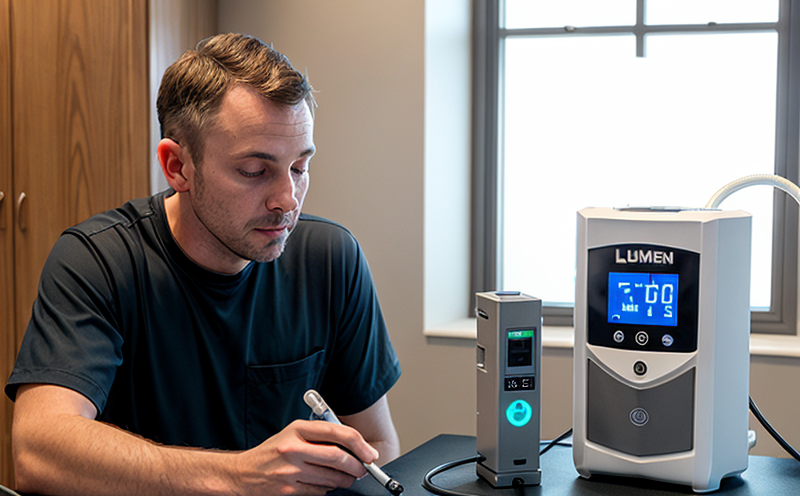EN 50289 Lifetime Bending Performance Testing of Lighting Cables
The EN 50289 standard is pivotal in ensuring the reliability and durability of lighting cables used in various applications, including commercial buildings, industrial facilities, and outdoor installations. This test evaluates how well a cable can withstand repeated bending cycles without compromising its performance or integrity.
Lighting cables are subjected to significant stress due to installation processes and daily use. They must be flexible enough for easy installation but robust enough to resist damage over time. The EN 50289 test simulates these real-world conditions by subjecting the cable to a series of bending cycles under controlled environmental conditions.
The testing process involves placing the cable into a specialized machine that applies consistent force, mimicking the stresses it would encounter during use and installation. The number of cycles is determined based on expected service life and the specific requirements of the application. After each cycle, the integrity of the cable is checked for any signs of degradation or failure.
For accurate testing, cables are preconditioned to ensure they are at a uniform temperature before being subjected to bending. This helps in simulating real-world conditions where temperature fluctuations can affect the performance of the cable. The test results are recorded meticulously and compared against the manufacturer's specifications to ensure compliance with EN 50289.
One critical aspect of this testing is understanding the impact on lumen maintenance, which refers to the rate at which a light source maintains its initial luminous flux over time. Cables that do not meet the required standards could lead to premature failure or reduced efficiency, affecting overall lighting performance and energy consumption.
By adhering to EN 50289, manufacturers can ensure their products are reliable and safe for use in demanding environments. This standard is particularly important in sectors where long-term reliability and safety are paramount, such as industrial manufacturing and large-scale commercial buildings. The test not only ensures compliance with international standards but also enhances the reputation of compliant products.
The testing process involves several steps:
- Conditioning the cable to a specific temperature
- Mounting it on a bending machine
- Applying defined bending cycles
- Checking for any signs of degradation or failure after each cycle
The acceptance criteria for this test are stringent, ensuring that only cables meeting the specified standards pass. This includes maintaining structural integrity and functionality throughout the testing process.
Applied Standards
EN 50289 is a European standard that sets out detailed specifications for the lifetime bending performance of lighting cables. It ensures that these cables can withstand repeated bending cycles without losing their mechanical or electrical properties over time.
The standard covers various types of lighting cables, including those used in indoor and outdoor applications. Compliance with EN 50289 is crucial for manufacturers looking to ensure the safety and reliability of their products while meeting regulatory requirements.
Manufacturers often use this test as part of their quality control process to verify that their products meet or exceed the specified standards. The testing procedure involves subjecting cables to a series of bending cycles, each designed to simulate real-world conditions they would encounter during installation and use.
The standard also emphasizes the importance of conducting these tests under controlled environmental conditions to ensure accurate results. This includes maintaining consistent temperature and humidity levels throughout the testing process. Compliance with EN 50289 is essential for ensuring product reliability and safety in demanding environments, such as industrial facilities and outdoor installations.
Manufacturers who comply with this standard can benefit from enhanced product performance, increased market credibility, and improved customer satisfaction. By adhering to these rigorous testing procedures, manufacturers demonstrate a commitment to quality and safety, which is critical for maintaining trust in the industry.
Environmental and Sustainability Contributions
- Better energy efficiency: Ensuring cables meet EN 50289 helps prevent premature failure, leading to longer-lasting products that maintain their performance over time. This reduces the need for frequent replacements, thereby conserving resources.
- Reduced waste: By improving product longevity and reliability, this testing contributes to a reduction in electronic waste generated by early failures or obsolescence.
Use Cases and Application Examples
The EN 50289 standard is particularly relevant for manufacturers of lighting cables used in various applications, including commercial buildings, industrial facilities, and outdoor installations. In commercial settings, the reliability and durability of these cables are crucial to ensure uninterrupted operation and safety.
In industrial environments, where cables may be subject to harsh conditions and frequent movement, compliance with EN 50289 ensures that they can withstand repeated bending cycles without compromising their performance. This is essential for maintaining optimal lighting levels and energy efficiency in these critical facilities.
Outdoor installations, such as streetlights or security systems, also benefit from the rigors of this testing. The standard helps ensure that cables can endure extreme weather conditions and environmental stresses, enhancing overall system reliability.





